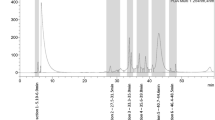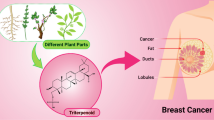Abstract
Edible green algal seaweeds, namely Ulva intestinalis and Ulva lactuca constitute a significant repository of popular herbal medicines in the Traditional Chinese Medicinal system. The present study aimed to assess the anticancer potential of these algal members and its mode of action in cervical cancer cells SiHa. The algal samples primarily extracted in methanol was fractionated into hexane, chloroform, and aqueous algal fractions, which inhibited the proliferation of SiHa cells in a dose-dependent manner, with the algal chloroform fractions harbouring the lowest IC50 dose of 141.38 µg/ml in U. intestinalis and 445.278 µg/ml in U. lactuca. These algal chloroform fractions when studied for their in-depth mode of action, were found to damage and pulverise the nuclei, resulting in a concomitant increase in subG0-phase of SiHa cells, studied by flow cytometry. The algal treatment also caused an increase in the number of acidic vesicles and enhanced the expression of LC3BII, p62 and atg12 proteins, which together pointed out autophagy as the induced mode of cell death. Upregulated Bax and p53 expression along with decreased Bcl2 expression also correlated to autophagic cell death. Decreased expression of E6 viral oncogene was noted as a significant response to algal fractions. Lastly, these potent algal fractions when characterised pharmacologically through GC–MS analysis were found to be rich in unsaturated fatty acids, majorly palmitic acid. Hence, this study concludes that the two species of Ulva successfully decreased the proliferation of SiHa cervical cancer cells through autophagy, hinting at palmitic acid being the major responsible bioactive compound in both.





Similar content being viewed by others
References
Ait-Mohamed O, Battisti V, Joliot V et al (2011) Acetonic extract of Buxus sempervirens induces cell cycle arrest, apoptosis and autophagy in breast cancer cells. PLoS ONE 6:e24537
Andrade KAM, Lauritano C, Romano G, Ianora A (2018) Marine microalgae with anticancer properties. Mar Drugs 16:165
Arsianti A, Fadilah F et al (2016) Phytochemical composition and anticancer activity of seaweeds Ulva lactuca and Eucheuma cottonii against breast MCF-7 and colon HCT-116 cells. Asian J Pharm Clin Res 11:115–119
Athamneh K, Hasasna HE, Samri HA et al (2017) Rhus coriaria increases protein ubiquitination, proteasomal degradation and triggers non-canonical Beclin-1 independent autophagy and apoptotic cell death in colon cancer cells. Sci Rep 7:11633
Berquin IM, Edwards IJ, Chen YQ (2008) Multi-targeted therapy of cancer by omega-3 fatty acids. Cancer Lett 269:363–377
Bray F, Ferlay J, Soerjomataram I, Siegel RL, Torre LA, Jemal A (2018) Global cancer statistics 2018: GLOBOCAN estimates of incidence and mortality worldwide for 36 cancers in 185 countries. CA Cancer J Clin 68:394–424
Breathnach AS (1999) Azelaic Acid: Potential as a general antitumoural agent. Med Hypotheses 52:221–226
Carrillo C, Cavia MM, Alonso-Torre SR (2012) Antitumor effect of oleic acid; mechanisms of action: a review. Nutr Hosp 27:1860–1865
de Jesus Raposo MF, de Morais AM, de Morais RM (2015) Marine polysaccharides from algae with potential biomedical applications. Mar Drugs 13:2967–3028
Deshpande R, Mansara P, Suryavanshi S, Kaul-Ghanekar R (2013) Alpha-linolenic acid regulates the growth of breast and cervical cancer cell lines through regulation of NO release and induction of lipid peroxidation. J Mol Biochem 2:6–17
Glick D, Barth S, Macleod KF (2010) Autophagy: cellular and molecular mechanisms. J Pathol 221:3–12
Gomes RN, Felipe da Costa S, Colquhoun A (2018) Eicosanoids and cancer. Clinics (Sao Paulo) 73:e530s
Hanada T, Noda NN, Satomi Y et al (2007) The Atg12-Atg5 conjugate has a novel E3-like activity for protein lipidation in autophagy. J Biol Chem 282:37298–37302
Harada H, Yamashita U, Kurihara H, Fukushi E, Kawabata J, Kamei Y (2002) Antitumor activity of palmitic acid found as a selective cytotoxic substance in a marine red alga. Anticancer Res 22:2587–2590
Harun FB, Syed Sahil Jamalullail SM, Yin KB, Othman Z, Tilwari A, Balaram P (2012) Autophagic cell death is induced by acetone and ethyl acetate extracts from Eupatorium odoratum In vitro: Effects on MCF- 7 and vero cell lines. Sci World J. https://doi.org/10.1100/2012/439479
Helmut B, Jagadeesan N, Robert WO (1999) Dietary polyunsaturated fatty acids and cancers of the breast and colorectum: emerging evidence for their role as risk modifiers. Carcinogenesis 20:2209–2218
Jia YL, Li J, Qin ZH, Liang ZQ (2009) Autophagic and apoptotic mechanisms of curcumin-induced death in K562 cells. J Asian Nat Prod Res 11:918–928
Jiang L, Wang W, He Q et al (2017) Oleic acid induces apoptosis and autophagy in the treatment of tongue squamous cell carcinomas. Sci Rep 7:11277
Jozwiak M, Filipowska A, Fiorino F, Struga M (2020) Anticancer activities of fatty acids and their heterocyclic derivatives. Eur J Pharmacol 871:172937
Kanzawa T, Germano IM, Komata T, Ito H, Kondo Y, Kondo S (2004) Role of autophagy in temozolomide-induced cytotoxicity for malignant glioma cells. Cell death differ 11:448–457
Kosanić M, Ranković B, Stanojković T (2015) Biological activities of two macroalgae from Adriatic coast of Montenegro. Saudi J Biol Sci 22:390–397
Lappano R, Sebastiani A, Cirrilo F et al (2017) The lauric acid-activated signalling prompts apoptosis in cancer cells. Cell Death Discov 3:17603
Lee YK, Lee JA (2016) Role of the mammalian ATG8/LC3 family in autophagy: differential and compensatory roles in the spatiotemporal regulation of autophagy. BMB Rep 49:424–430
Lippai M, Lőw P (2014) The role of the selective adaptor p62 and ubiquitin-like proteins in autophagy. BioMed Res Int. https://doi.org/10.1155/2014/832704
Marquez RT, Xu L (2012) Bcl-2: Beclin 1 complex: multiple, mechanisms regulating autophagy/apoptosis toggle switch. Am J Cancer Res 2:214–221
Mathew R, Karantza-Wadsworth V, White E (2007) Role of autophagy in cancer. Nat Rev Cancer 7:961–967
Mosmann T (1983) Rapid colorimetric assay for cellular growth and survival: application to proliferation and cytotoxicity assays. J Immunol Methods 65:55–63
Opipari AW Jr, Tan L, Boitano AE, Sorenson DR, Aurora A, Liu JR (2004) Resveratrol induced autophagocytosis in ovarian cancer cells. Cancer Res 64:696–703
Pacheco BS, dos Santos MAZ, Schultze E et al (2018) Cytotoxic activity of fatty acids from antarctic macroalgae on the growth of human breast cancer cells. Front Bioeng Biotechnol 6:185
Pal A, Kundu R (2020) Human papillomavirus E6 and E7: The cervical cancer hallmarks and targets for therapy. Front Microbiol 10:3116
Paul S, Kundu R (2013) Antiproliferative activity of methanolic extracts from two green algae Enteromorpha intestinalis and Rhizoclonium riparium on HeLa cells. Daru J Pharm Sci 21:72
Sou YS, Waguri S, Iwata JI et al (2008) The Atg8 conjugation system is indispensable for proper development of autophagic isolation membranes in mice. Mol Biol Cell 19:4762–4775
Sridharan S, Jain K, Basu A (2011) Regulation of autophagy by kinases. Cancers 3:2630–2654
Uddin SJ, Grice D, Tiralongo E (2012) Evaluation of cytotoxic activity of patriscabratine, tetracosane and various flavonoids isolated from the Bangladeshi medicinal plant Acrostichum aureum. Pharm Biol 50:1276–1280
Wang K, Liu R, Li JY, Mao JL, Lei YL, Wu JH et al (2011) Quercetin induces protective autophagy in gastric cancer cells: involvement of Akt-mTOR- and hypoxia-induced factor 1a-mediated signaling. Autophagy 7:966–978
Wang J, Kim TH, Ahn MY, Lee J, Jung JH, Choi WS et al (2012) Sirtinol, a class III HDAC inhibitor, induces apoptotic and autophagic cell death in MCF-7 human breast cancer cells. Int J Oncol 41(3):1101
Wang X, Chen Y, Wang J, Liu Z, Zhao S (2014) Antitumor activity of a sulphated polysaccharide from Enteromorpha intestinalis targeted against hepatoma through mitochondrial pathway. Tumour Biol 35:1641–1647
Wang X, Qi W, Li Y, Zhang N, Dong L, Sun M et al (2015) Huaier extract induces autophagic cell death by inhibiting the mTOR/S6K pathway in breast cancer cells. PLoS ONE 10(7):e0131771
Wells ML, Potin P, Craigie JS et al (2017) Algae as nutritional and functional food sources: revisiting our understanding. J Appl Phycol 29:949–982
White E, Di Paola RS (2009) The double-edged sword of autophagy modulation in cancer. Clin Cancer Res 15:5308–5316
Wickramasinghe NS, Jo H, McDonald JM, Hardy RW (1996) Stearate inhibition of breast cancer cell proliferation. A mechanism involving epidermal growth factor receptor and G-proteins. Am J Pathol 148:987–995
Wu M, Lao Y, Xu N, Wang X, Tan H, Fu W, Lin Z, Xu H (2015) Guttiferone K induces autophagy and sensitises cancer cells to nutrient stress-induced cell death. Phytomedicine 22:902–910
Xu Y, Qian SY (2014) Anti-cancer activities of ω-6 polyunsaturated fatty acids. Biomed J 37:112–119
Yee SK, Wilkinson S, James J, Ryan KM, Vousden KH (2009) PUMA and Bax-induced autophagy contributes to apoptosis. Cell Death Differ 16:1135–1145
Zanoaga O, Jurj A, Raduly L et al (2018) Implications of dietary & -3 and & -6 polyunsaturated fatty acids in breast cancer. Exp Ther Med 15:1167–1176
Acknowledgements
Authors wish to acknowledge Centre of Advanced Study, Department of Botany, University of Calcutta, Centre for Research in Nanoscience and Nano-technology, University of Calcutta and Department of Biotechnology, University of Calcutta for research facility. Authors also wish to thank DST-FIST, Department of Botany, University of Calcutta for GC-MS facility. Mr. Soumya Chatterjee and Prof. Arindam Bhattacharyya, Department of Zoology, University of Calcutta is duly acknowledged for the assistance regarding PBMC isolation. SP, AP and PV acknowledges UGC for research fellowship. IM acknowledges WB-DST for research fellowship.
Funding
This work was supported by Department of Science and Technology, West Bengal, India (WB-DST) [778(Sanc)/ST/P/S&T/9G-14/2010; 7/10/2013].
Author information
Authors and Affiliations
Contributions
AP and PV performed the experiments under the guidance of SP and IM. SP, IM and RK conceptualised and designed the study. Data analysis, representation, manuscript writing and editing by AP, and reviewed by RK.
Corresponding author
Ethics declarations
Conflict of interest
The authors declare that they have no conflict of interest in the publication.
Ethics approval
This guidelines followed for blood isolation from healthy volunteer donors have been approved by the Institutional Ethical Committee.
Consent to participate
Informed consent was obtained from the participant prior to blood collection.
Consent for publication
All the authors gave their relevant consent for publication.
Availability of data and material
All the relevant data have been included in the article.
Rights and permissions
About this article
Cite this article
Pal, A., Verma, P., Paul, S. et al. Two species of Ulva inhibits the progression of cervical cancer cells SiHa by means of autophagic cell death induction. 3 Biotech 11, 52 (2021). https://doi.org/10.1007/s13205-020-02576-9
Received:
Accepted:
Published:
DOI: https://doi.org/10.1007/s13205-020-02576-9




